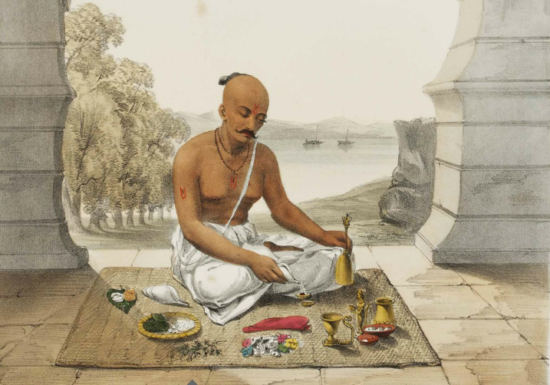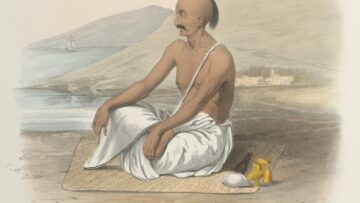तिला᳚श्च मे मु॒द्गाश्च॑ मे ख॒ल्वा᳚श्च मे गो॒धूमा᳚श्च
Tilaashcha me mudgaashcha me khalvaashcha me godhuumaashcha
Chamakam | Anuvaka 4
Our objective is to understand the process by which cultures are controlled via control of language. Indologists control Sanskrit by a structured process of ‘word’, ‘meaning’ and ‘literature’ re-definitions and re-interpretations. These are frequently in opposition to the intellectual consensus and philosophical beliefs within the native episteme and traditions. These re-definitions are critical to the appropriative process and ultimately generate a body of ‘factoids’ that become the Intellectual Property of the Indological enterprise and in effect transfers the locus of ‘ownership’ from the natives to the western academe. These factoids are then skillfully woven into source documents and academic articles to create and fix new narratives. Basically, he who defines, owns the narrative.
To dismantle these Indological narratives, we need to ask two questions (a) are these Indological factoids themselves true and substantiated? (b) Are the Indological ‘claims’ which are constructed using these factoids true and validated?
There is a third question (c) Under the guise of disinterested scholarship, is it morally and ethically right to indulge in such epistemic violence and cultural appropriation that cause harm to native traditions? However, this discussion is not within the scope of the article.
Here, we take the example of godhuma/wheat to interrogate both (a) the validity of the Indological factoids as well as (b) the truth of the Indological claims built on these factoids.
In Part 1 [ https://www.indictoday.com/long-reads/wheat-and-witzel-sanskrit-indology-cowsmoke-i/ ], we dug deep into the roots of the factoid generation process and evaluated its validity. We looked at how godhuma (wheat) was given a new etymology (‘factoid’) by German Indologists who ‘christened’ it {cow-smoke or earth-smoke} while ignoring or rejecting the existing, widely accepted Sanskrit etymology {covering-friend-protector}. We also identified the series of errors of judgment and scholarship made by first-generation European Indologists including Böhtlingk, Wackernagel and Monier Williams that ultimately led to this laughably erroneous ‘cow-smoke’ etymology. We showed how this factoid is flawed, both in etymology and scholarship.
Let us now evaluate the second question – are the Indological ‘claims’ built using these factoids valid? To maintain continuity, we will continue with the same godhuma example as a case study of how Indologists deploy erroneous etymologies and inadequate references across multiple ‘peer-reviewed’ articles in an effort to substantiate unfounded theories.
A Background to Witzel
As experienced every day, the pernicious Indological Aryan invasion / migration theory continues to exert a real impact on the politics, identity, language and cultural dynamics within modern India. When we look at the evidence originally deployed for building and substantiating this ‘invasion hypothesis’, we find that it was predominantly a linguistic theory.
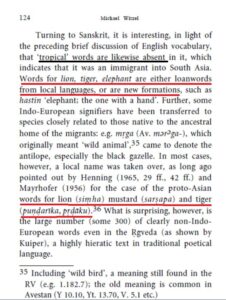 Michael Witzel, the Wales Professor of Sanskrit, Harvard University has been one of the most prominent modern Indologists supporting an Aryan invasion / migration narrative based predominantly on linguistic claims.
Michael Witzel, the Wales Professor of Sanskrit, Harvard University has been one of the most prominent modern Indologists supporting an Aryan invasion / migration narrative based predominantly on linguistic claims.
A foundational claim of Witzel is that Sanskrit is an ‘immigrant to South Asia’ and the absence as well as the presence of specific words in Sanskrit are markers of its origin and ‘foreignness’ of its speakers vis-à-vis India. By a study of the cultural loan words in early Vedic texts, one can draw conclusions on the ‘trends’ in pre-Vedic civilization.
For example, he claims that ‘tropical’ words are absent in Sanskrit. Such words are loan-words or new formations and gives the examples of हस्तिन् (elephant) and मृग to substantiate a non ‘South Asian’ origin for Sanskrit. According to Witzel, ‘cultural loan’ words for rice, wheat, sugarcane, sesame, dog, cow, horse, chariot, brick, copper and iron are important indicators of Sanskrit’s foreign origins. 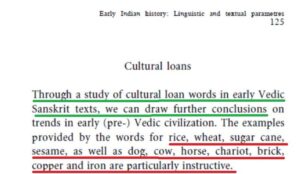
Taking rice as an example, he claims “The absence of rice in the oldest strata of Rgvedic texts is not surprising. Unless the Rgvedic words (brahma-)odana and purodaś mean a certain rice dish, as they do later, cultivation and ritual use of rice first appear in the Atharvaveda (as in the word vrīhi, etc.). Instead, the Rgvedic Indo-Aryans relied mainly on pastoralism and the growing of some barley (but, typically, not wheat), which had been a staple of the Indus Civilization.”
Here, by showing that rice is absent in the Rg Veda, Witzel’s purpose is to claim that the mythical “Aryans” were pastoralists who grew Barley, but “not wheat” and came into contact with rice much later post-migration. Hence, they were foreigners who came to India.
Witzel’s Wheat
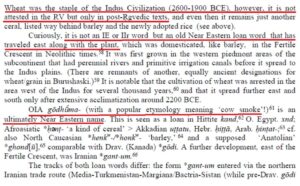 Witzel has consistently referred to the foreign origin for wheat and the etymology of “godhuma = cow smoke” as a part of his evidence repertoire to substantiate the eastward migration and foreign status of the so-called ‘Aryans’. Witzel’s core claims are captured well in ‘The Linguistic History of Some Domestic Indian Plants (2009)’ shown here.
Witzel has consistently referred to the foreign origin for wheat and the etymology of “godhuma = cow smoke” as a part of his evidence repertoire to substantiate the eastward migration and foreign status of the so-called ‘Aryans’. Witzel’s core claims are captured well in ‘The Linguistic History of Some Domestic Indian Plants (2009)’ shown here.
Given the vastness of the ‘Aryan’ literature and the academic outpouring from Witzel, let us focus on a very limited objective here: evaluate the strength of evidence Witzel brings to bear for his ‘foreign’ claims by looking into just one variable, ‘godhuma/wheat’ from his portfolio of evidence -. To do the evaluation, we will utilize the well known स्थालीपुलाकन्यायः, first enunciated by Patanjali Maharshi in his classic Mahabhashya (पर्याप्तो ह्येकः पुलाकः स्थाल्या निदर्शनाय 1.4.23). This philosophical ‘razor’ posits that we need check only one grain of rice (sampling) to see if all grains in the pot are cooked (ex uno disce omnes).
1. Early Phase
One of the initial publications from Witzel that incorporates the godhuma storyline is ‘Early Indian History: Linguistic and Textual Parameters’ (1995) where he writes:
Western influence is seen in godhūma ‘wheat’, a derivative of Iranian*ganduma (Avestan -.gantuma), which can be traced back to such Near Eastern words as Hittite kant, Egyptian. xnd, Semitic *hantim (pl.) (Mayrhofer 1956,I: 348; Berger 1959: 40 ff.).
At the same time, Sanskrit go-dhūma, which is based on a popular etymology (‘cow-smoke’) clearly has been influenced by Dravidian forms as well, e.g., Kannada gōdi, Tamil kōti. The age of this loanword is not clear, due to the mixture of Iranian and Dravidian influence.
He also thinks aloud: “Could Avestan gantuma, Dravidian (Kannada) gōdi, be connected with the name of the country of Gandhara, which probably is due to a popular etymology as well (cf. Skt gandha, Gandharva)?
As a part of the ‘claims’ stating foreignness of “Aryans” and their language “Sanskrit” to India, Witzel is using the ‘godhuma’ factoid to make a few axiomatic claims as well as throwing a few hypotheses in the air.
1. Wheat is NOT a native cereal and ‘clearly’ came to India from the west.
We do not know exactly where it originated, but it certainly was NOT India.
2. Hence, the Sanskrit name for wheat, ‘godhuma’ can only be a ‘loan word’ and cannot be a real Sanskrit word.
Why? Because there are multiple similar sounding words for wheat in West/Central Asian languages as well as most Indian languages. So, the name must have been loaned to Sanskrit.
3. Since Sanskrit borrowed the word godhuma, there can be no meaning in Sanskrit.
Why? Because if it is a foreign word, then Sanskrit cannot logically generate any primary meaning. Any meaning generated will essentially be ‘reverse engineering’.
4. Given the artificiality, we can only expect a ‘popular-etymology’ like cow-smoke.
All native or traditional Sanskrit explanations are without merit or suspect!
 To back up his claims, Witzel provides two key Indological references in this paper:
To back up his claims, Witzel provides two key Indological references in this paper:
- Kurzgeffastes Etymologisches Wörterbuch des Altindischen – KEWA [Concise Etymological Dictionary of Ancient Indian] 1956 by Manfred Mayrhofer
- Die Burušaski-Lehnwörter In Der Zigeunersprache [The Burushaski Loanwords in the Gypsy language] 1959 by Hermann Berger
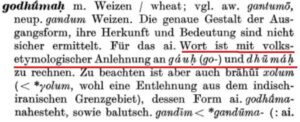 According to Mayrhofer’s KEWA reference
According to Mayrhofer’s KEWA reference
the exact….origin and meaning have not been determined with certainty….folk etymology based on gauh and dhumah is to be expected.
Discussing the series of claims around a semitic origin via the Semitic*hantim, Mayrhofer adds: *hypothetical*
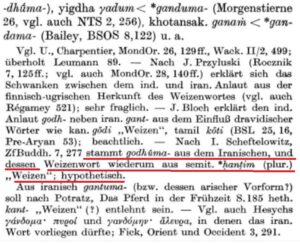 Berger’s Burushaski Loanwords in the Zigeuner (Gypsy or Romany) language examines the Burushaski language word for wheat – {gurin} and goes through a series of complicated linguistic maneuvers to claim that an original form *gurum transformed to *gorum (because ‘u’ can change to ‘o’ before ‘r’) – which voila, is ‘strikingly similar’ to the “Aryan” form godhuma. He goes on to say that a more detailed phonetic investigation can probably make etymological context clearer and the Burushaski borrowing thesis ‘more robust’.
Berger’s Burushaski Loanwords in the Zigeuner (Gypsy or Romany) language examines the Burushaski language word for wheat – {gurin} and goes through a series of complicated linguistic maneuvers to claim that an original form *gurum transformed to *gorum (because ‘u’ can change to ‘o’ before ‘r’) – which voila, is ‘strikingly similar’ to the “Aryan” form godhuma. He goes on to say that a more detailed phonetic investigation can probably make etymological context clearer and the Burushaski borrowing thesis ‘more robust’.
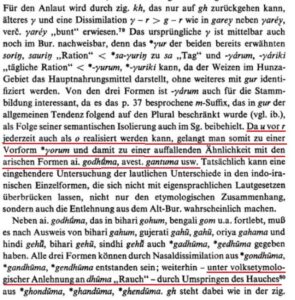 In this paper, Witzel indulges freely in unfounded speculation that godhuma is ‘clearly influenced’ by Dravidian forms. The ‘how’ or ‘why’ is not clearly mentioned. He also starts merrily spitballing that ‘gandha’, ‘gandharva’ and ‘gandhara’ are somehow connected to godhuma. In fact, it seems that he is willing to entertain any and all ideas, as long as it is not Sanskrit.
In this paper, Witzel indulges freely in unfounded speculation that godhuma is ‘clearly influenced’ by Dravidian forms. The ‘how’ or ‘why’ is not clearly mentioned. He also starts merrily spitballing that ‘gandha’, ‘gandharva’ and ‘gandhara’ are somehow connected to godhuma. In fact, it seems that he is willing to entertain any and all ideas, as long as it is not Sanskrit.
We can make some initial assessments:
- For a professor of Sanskrit, Witzel does not seem to consider it fit to evaluate the existing Unadi Sutra or ShabdaKalpadrumah based etymology of godhuma at any point in his analysis.
- He even refuses to refer to Indological sources such as Bohtlingk’s Petersburger Wörterbuch, which at least links to the Unadi Sutra etymology. He only provides later Indology references that obviously argue the case in a certain direction.
- We already know that the later German reference sources, which posit ‘cow smoke’ or ‘earth-smoke’ are flawed methodologically and etymologically.
So, based on these weak and speculative references, as well as the deluge of hypotheticals used, Witzel’s case for the ‘foreignness’ of godhuma (‘Indological claim’) is unconvincing.
स्थालीपुलाकन्यायः Verdict = Uncooked
2. Reworking the Storyline
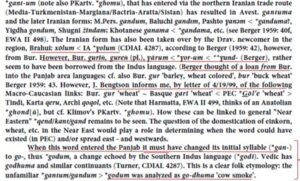 In Early Sources for South Asian Substrate Languages (1999), written 5 years later, Witzel throws overboard one of his key references (Berger 1959) saying that contrary to his earlier analysis, Burushaski language got the gurin word for wheat from the Indus language – not the other way around. The direction of borrowing is now diametrically opposite to what was claimed 5 years earlier!
In Early Sources for South Asian Substrate Languages (1999), written 5 years later, Witzel throws overboard one of his key references (Berger 1959) saying that contrary to his earlier analysis, Burushaski language got the gurin word for wheat from the Indus language – not the other way around. The direction of borrowing is now diametrically opposite to what was claimed 5 years earlier!
This is academically perfectly valid and when new information comes in, a good researcher re-evaluates the evidence for the hypothesis. However, one should pause to reflect the impact on the original thesis also. This is perceptibly missing in this paper.
Witzel now doubles down on his hypothesis and claims “when this word entered ‘Panjab’, it must have changed its initial syllable *gan- to *go, changing from ganduma to godum”. Evidence provided for the assertion = None.
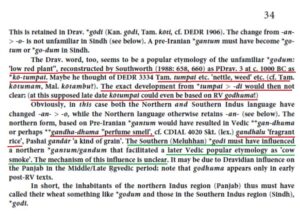 Witzel then goes on a Southern tangent and tries to generate a completely different etymology for the ‘Dravidian’ equivalent words for godhuma like kotumpai (Tamil) and kotambu (Malayalam). He refers to Southworth’s claim that ko-tumpai is from ‘low-red-plant’ and ‘nettle, weed’ etc. He also suggests, quite randomly once again, that the etymology could be from ‘gandha-dhuma or perfume smell’. He says that “the Southern Meluhhan *godi must have influenced a northern Vedic *gantum”. Witzel claims that ‘gantum’ facilitated a later, popular ‘Vedic etymology’ of ‘cow-smoke’, a farcical and unsubstantiated statement for a ‘Sanskrit Professor’ to make.
Witzel then goes on a Southern tangent and tries to generate a completely different etymology for the ‘Dravidian’ equivalent words for godhuma like kotumpai (Tamil) and kotambu (Malayalam). He refers to Southworth’s claim that ko-tumpai is from ‘low-red-plant’ and ‘nettle, weed’ etc. He also suggests, quite randomly once again, that the etymology could be from ‘gandha-dhuma or perfume smell’. He says that “the Southern Meluhhan *godi must have influenced a northern Vedic *gantum”. Witzel claims that ‘gantum’ facilitated a later, popular ‘Vedic etymology’ of ‘cow-smoke’, a farcical and unsubstantiated statement for a ‘Sanskrit Professor’ to make.
At this point, probably alarmed at the increasing senselessness of the story, he applies for anticipatory bail saying “kotumpai actually could also be based on RV (sic) godhuma” which is diametrically opposed to his original Sanskrit borrowing from Dravidian assertion! Talk about covering all bases! Aryans are now practically whizzing all over the map in all random directions.
Detour 1 : The Indological Big Lie and the “Tell”
One thing to notice here is the profusion of statements that portends the presence of an ‘Indological Big Lie’ in these papers. We may ask, what is the Indological big lie and what are the signs or ‘tells’ that alert us to this phenomenon?
In Indology papers where the case is weak, authors somehow have to cross a logical or evidentiary chasm – a ‘bridge too far’, in order to prove their thesis. The favourite strategy to cross that evidentiary gap is by using certain phrases that are designed to paper-over the chasms without raising the suspicion of the readers. A few examples of such ‘tells’ are phrases such as (a) “Must have” (b) “Mechanism is unclear” (c) “it must therefore be” (d) “scholarly consensus” (e) “in all likelihood” (f) “it is very unlikely” (g) “cannot be disputed” etc.
Whenever we see the presence of these ‘tells’, the reader ought to perk up their ears and listen for the Indological Big Lie coming down the road! Here we see numerous ‘must haves’ and ‘mechanism is unclear’ statements. We also see Witzel ‘arguing both sides of a statement’ in this article – statements suggesting that godhuma came from Dravidian to Sanskrit as well as from RgVedic (sic) Sanskrit to Dravidian. Truly vexing scholarship, to say the least!
स्थालीपुलाकन्यायः Verdict = Still uncooked.
3. The Mature Phase
Let us now look at a later example of the Witzelian claims re-use cycle – a 2009 publication The Linguistic History of Some Indian Domestic Plants.
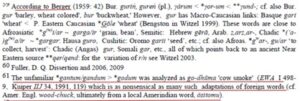 Witzel reiterates the same *gantum to godum transformation in ‘Panjab’ while letting go of the previous sweet-smelling (gandha) smoke speculations. He now claims that {go-dhuma = ‘cow-smoke’} etymology is ultimately a nonsensical word, similar to how the American ‘woodchuck’ (gopher) arose from the native ‘ositomu’. This is Harvard’s Wales Professor of Sanskrit speaking now!
Witzel reiterates the same *gantum to godum transformation in ‘Panjab’ while letting go of the previous sweet-smelling (gandha) smoke speculations. He now claims that {go-dhuma = ‘cow-smoke’} etymology is ultimately a nonsensical word, similar to how the American ‘woodchuck’ (gopher) arose from the native ‘ositomu’. This is Harvard’s Wales Professor of Sanskrit speaking now!
However, to compensate for the unseasonal mortality of his earlier references, Witzel now brings in two fresh references to prove his case:
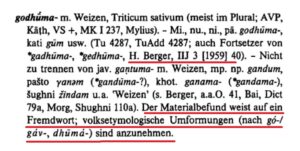 (a) Mayrhofer’s newer Etymologisches Wörterbuch des AltIndoarischen – EWA (Etymological Dictionary of Ancient IndoAryan, 1992)
(a) Mayrhofer’s newer Etymologisches Wörterbuch des AltIndoarischen – EWA (Etymological Dictionary of Ancient IndoAryan, 1992)
(b) F B J Kuiper’s review of EWA in IIJ 34.
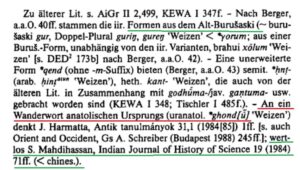 In EWA, Mayrhofer improves upon his original hypothetical pronouncement in KEWA that the “origin and meaning have not been determined with certainty….gauh and dhumah is to be expected”. He now posits that folk etymological transformations are to be assumed for go->gav-dhuma. Mayrhofer firmly says in EWA that the ‘material findings indicate a foreign word’ and that the original word is *ghond, a ‘wandering word of Anatolian origin’, based on the opinion of J Harmatta. Ominously, he also refers to Berger’s 1959 Burushaski article that Witzel has already thrown overboard by this time.
In EWA, Mayrhofer improves upon his original hypothetical pronouncement in KEWA that the “origin and meaning have not been determined with certainty….gauh and dhumah is to be expected”. He now posits that folk etymological transformations are to be assumed for go->gav-dhuma. Mayrhofer firmly says in EWA that the ‘material findings indicate a foreign word’ and that the original word is *ghond, a ‘wandering word of Anatolian origin’, based on the opinion of J Harmatta. Ominously, he also refers to Berger’s 1959 Burushaski article that Witzel has already thrown overboard by this time.
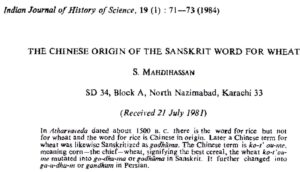 An interesting and funny point to note is that Mayrhofer deigns it worth his time to incorporate non-western views also in EWA. He reviews a certain S Mahdihassan, a prolific researcher from Karachi, Pakistan whose pet thesis was a Chinese origin for ‘godhuma’ (from ko-t’ ou-me in Chinese -> godhuma -> gandum in Persian), essentially a reverse Aryan migration from China due West!
An interesting and funny point to note is that Mayrhofer deigns it worth his time to incorporate non-western views also in EWA. He reviews a certain S Mahdihassan, a prolific researcher from Karachi, Pakistan whose pet thesis was a Chinese origin for ‘godhuma’ (from ko-t’ ou-me in Chinese -> godhuma -> gandum in Persian), essentially a reverse Aryan migration from China due West!
This ‘masterly’ 3-page article, published in the Indian Journal of History of Science (1984) was graciously reviewed by Mayrhofer with the immortal word ‘wertlos’ {worthless!}
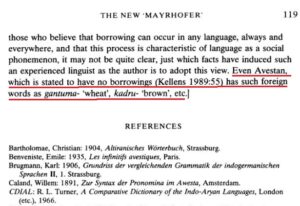 F B J Kuiper’s “The New Mayrhofer’ is Witzel’s second new reference to substantiate the godhuma thesis. The entirety of godhuma related information contained in this 15-page article is a single, throw-away, last line on the last page (119): “Even Avestan…has such foreign words as gantuma – wheat’.
F B J Kuiper’s “The New Mayrhofer’ is Witzel’s second new reference to substantiate the godhuma thesis. The entirety of godhuma related information contained in this 15-page article is a single, throw-away, last line on the last page (119): “Even Avestan…has such foreign words as gantuma – wheat’.
That . is . it. The entire reference!
One does not know whether to pull one’s hair out in frustration or marvel at the chutzpah of such magnificent Harvardian wizardry.
So, this third पुलाकः expedition also has come a cropper. The evidence provided is consistently sketchy, the references are hypotheticals, and it is impossible to come to any firm conclusion!
स्थालीपुलाकन्यायः Verdict = Wholly uncooked pot unfit for consumption.
In between 1995 and 2009, Witzel has faithfully repeated the same information across multiple other articles. To avoid gobbling down the whole pot of पुलाकः and to save space, the table below compiles a few of these instances:
| 1999 | Aryan and non-Aryan names in Vedic India | From W. Asia, however, stem: (1) godhūma ‘wheat’; Nur. gūm; Hi. gohũ/gehũ/gahũ :: Avest. ga_tuma, MP. Dravidian (Kan. gōdi, Tam. kōti, cf. DED 1906), etc. go back to a word found in Egypt. xnd, Hittite kant, Semit. *_an_. |
| 1999 | Early Sources for South Asian Substrate Languages | Wheat, however, was the staple of the Indus civilization, and was called in Dravidian by an adaptation of a local word: *gō-di ‘low red plant’ (Southworth 1988, 1979, 1990) which is quite different from the Panjab word *go-dum > Vedic godhūma ‘cow smoke’ |
| 2000 | The Languages of Harappa (Early linguistic data and the Indus civilization) | There are a number of facts which point to a dialect difference between the northern and southern Indus language. Wheat, the staple of the Indus civilization, is called in Dravidian by an adaptation of a local word: *gō-di ‘low red plant’ (Southworth 1988, 1979, 1990) which is quite different from the Panjab word *go-dum > Vedic godhūma ‘cow smoke’ (but note Avestan gantuma!). |
| 2001 | Autochthonous Aryans? The Evidence from Old Indian and Iranian Texts | It appears only later on, in Middle Vedic texts (godhūma, MS 1.2.8+). The form of the word is of clear Near/Middle Eastern origin (Hittite kant, O.Egypt. xnd, Avestan gantuma), but it has been influenced by popular etymology (Skt. go-dhūma ”cow smoke”). It echoes, in its initial syllable, the Dravidian word for ‘wheat’ (Kannada gōdi, Tamil kōti) |
Witzel consistently claims across these articles that the words ‘godhuma’ and ‘godi’ have no connection except ‘echoes in its initial syllable’! He is quite clear that the Dravidian forms (godi, kotambu, godambu) are etymologically different from the northern godhuma, even though they sound similar and mean the same. Talk about selective picking and choosing!
In addition, Witzel’s putative connection between Aryan migration and godhuma’s foreignness is also quite mysterious. If godhuma were to be a foreign cereal originating to the west of India, the migrating Aryans should have encountered it well before they reached India. This is a logical challenge that Witzel tries to carefully sidestep via the proactive alibi statements like “Rgvedic Indo-Aryans relied mainly on pastoralism and the growing of some barley (but, typically, not wheat) and ‘the cultivation of wheat was arrested in the area west of the Indus for several thousands of years’.
To be honest, it must be stated that it is always possible to debate the case for godhuma to be a ‘foreign’ cereal and to be a ‘loan-word’ word to Sanskrit. However, we need archeological, archeobotanical/zoological, hydrological, isotope dating, climate science, genomics and other evidence to be brought to bear on this topic, apart from linguistics, to have a meaningful discussion. While there are minimal references used from these sources, the overall arguments and conclusions from Witzel are certainly unsatisfactory and inconclusive.
Based on all these articles, we see no pathbreaking evidence or fundamentally new information that Witzel provides over the years. He seems to be cycling through a bunch of references from the same uncooked Indological pot, while completely ignoring the accepted Sanskrit etymology and acting as if they do not even exist. Over 15 years, Witzel pretty much repeats the same sentences, phrases and themes, in ever desperate and shriller cycles, as his promised vision of marauding Aryans seems to recede further and further into the horizon.
In conclusion, based on the evidence provided, the second objective we set out to evaluate, “Are the Indological ‘claims’ constructed using these factoids true?” is also answered in the negative as far as ‘godhuma’ is concerned.
Detour 2: Refereeing the References
Until now, we have been looking at the validity of the Indological factoids, the nature of specific references used and the strength of evidence provided by these references to evaluate if Witzel’s claims stand up to scrutiny. However, there is another important issue to consider.
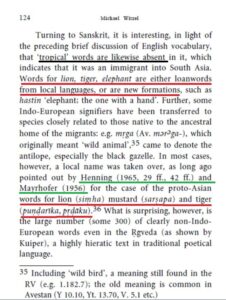 How do we know if these references are actually saying what the author claims they are saying? Are there situations where the author uses some reference to prove a specific claim, but the referred information is, in reality, contradicting what the author is claiming? Unless we carefully read through the provided references, we cannot evaluate this scenario. Let us now take a brief look at one reference (Early Indian History -1995) already used at the beginning of this article.
How do we know if these references are actually saying what the author claims they are saying? Are there situations where the author uses some reference to prove a specific claim, but the referred information is, in reality, contradicting what the author is claiming? Unless we carefully read through the provided references, we cannot evaluate this scenario. Let us now take a brief look at one reference (Early Indian History -1995) already used at the beginning of this article.
Witzel uses two sources, Henning (1965, 29-42ff) and Mayrhofer (1956) to claim “some IE signifiers have been transferred to species closely related to those native to the ancestral homeland (मृग)….in most cases, a local name was taken over…for the case of the proto-Asian words for lion (सिंहः), mustard (सर्षपः) and tiger (पुण्डरीकः, पृदाकुः).
To put it in simple terms, Witzel claims that Sanskrit words like मृग were used in the original Aryan ‘homeland’ for things found only there and the migrating Aryans subsequently ‘re-purposed’ these terms for similar categories they encountered in India. However, for animals, plants and things that were absent in their homeland like सिंहः (lion), सर्षपः (mustard) and पृदाकुः (tiger) they borrowed the Sanskrit names from the ‘local’ language once they arrived in India.
Walter Bruno Henning, in his article “A Grain of Mustard” examines the etymology of mustard (सर्षपः / sarson) and actually refers to Theodor Benfey’s view that in fact, a Sanskrit or Indian (‘mother of all culture’) word may have travelled to Persia. He also mentions that the Sanskrit, Avestan, Sogdian, Parthian, Greek, Persian, Arab and Khotanese words are not necessarily loan words or cognates. Henning ultimately provides a hypothetical non-IE root word (s1 sens2 ap) that was adopted by both Iranians and “Indo-Aryans.” What Henning is saying and what Witzel is claiming seems totally disconnected.
 In the example of Lion, while Witzel confidently mentions “words for Lion, Tiger…are loanwords..or new formations”, Henning writes that सिंहः belongs to the most ancient layer of Sanskrit. So, Henning’s reference is diametrically opposite to Witzel’s claim of ‘a local word was taken over’ or ‘word carried from ancient homeland’.
In the example of Lion, while Witzel confidently mentions “words for Lion, Tiger…are loanwords..or new formations”, Henning writes that सिंहः belongs to the most ancient layer of Sanskrit. So, Henning’s reference is diametrically opposite to Witzel’s claim of ‘a local word was taken over’ or ‘word carried from ancient homeland’.
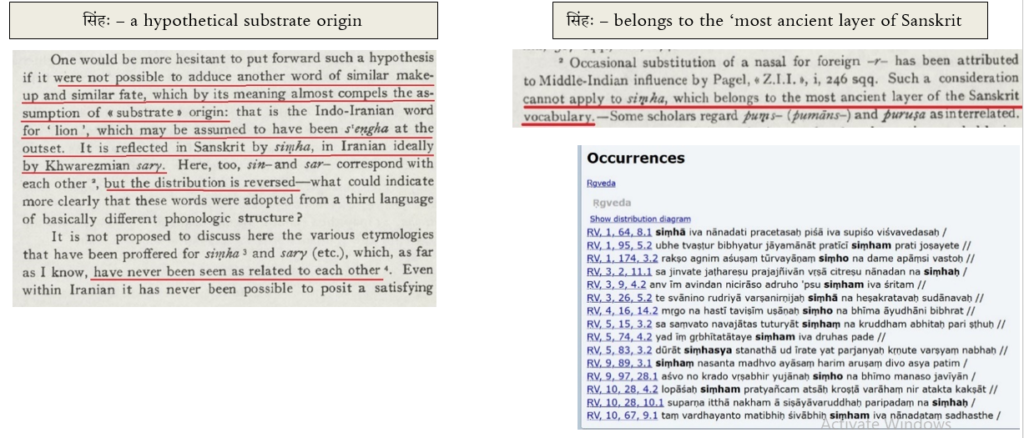
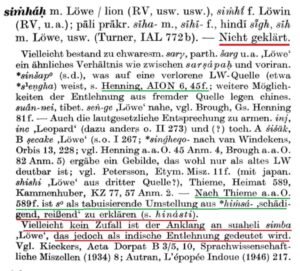 Incidentally, the Rg Veda shows 15 references to Simha that highlights Henning’s assertions.
Incidentally, the Rg Veda shows 15 references to Simha that highlights Henning’s assertions.
Mayrhofer (1956) suggest that Simha etymology is not clear. After referring to Henning, he refers to Thieme, who suggests a taboo-based change-over from ‘himsa’ which curiously enough is as per Sanskrit tradition (सिंहो वर्णविपर्य्ययात् – हिनस्तीति सिंहः). He also comments on an echo between Swahili ‘simba’ and Indian ‘Simha’.
As shown in these examples, there does not seem to be any connection between many of Witzel’s claims and the actual information contained in the references he is using to substantiate his claims.
In any academically sound, peer-reviewed paper, if the claim and the references do not match, it would be considered a serious editorial, methodological or ethical flaw. We do not know why Witzel’s references are not substantiating his claims but are in fact, saying the opposite of his assertions. The readers may wonder why this is the case – is it an error of omission or commission? The answers to these questions have implications for the overall credibility and quality of Indological and Sanskrit scholarship.
Critique of Indology as an Academic Discipline
Indology as a discipline has been coming under increasing academic and ethical scrutiny given the various issues that plague it, including racism, Nazism, anti-semitism and plagiarism. According to Adluri and Bagchee’s The Nay Science (2014), which undertook an inquiry into German Indology, “In place of scientific criteria, we found Protestant, fundamentalist, anti-Catholic, anti-Semitic, anti-Judaic, anti-Brahmanic, nationalistic, and racist prejudices masquerading as scholarship under the banner of ‘Wissenschaft’ (science)”.
The charges of racism and religious fundamentalism has always dogged the founding fathers of German Indology including folks like Christian Lassen, Hermann Oldenberg, Richard von Garbe and have continued to engulf more modern and current Indologists as shown by Adluri and Bagchee. Paul Hacker (1913-1979), a well-known Indological ‘Vedanta expert’ has been shown to have had membership of the Nazi party.
The institutional corruption that clouds Indology is best highlighted by the example of the Leipzig University Chair of Indology. Johannes Hertel (1872-1955) and Friedrich Weller (1889-1980), two ‘illustrious’ prior occupants of the Leipzig Chair of Indology have been connected via primary evidence to anti-semitism and Nazism. Eli Franco, the current chair has been shown by Adluri and Bagchee to have plagiarized from Klaus Mylius, Manfred Taube and Alexander von Rospatt. Sheldon Pollock in 2019 and Wendy Doniger in 2018 accepted the Friedrich Weller prize, despite the Nazi taint that is attached to both Weller and the prize.
Apart from ethical issues, we saw how issues of scholarship and academic integrity are ever-present in Indology leading to an untenable situation for the discipline.
- We saw how the works of many first and second-generation European Indologists like Böhtlingk, Wackernagel, Monier Williams, Mayrhofer, etc. have significant errors in their foundational works.
- We evaluated how Indology tends to ignore and de-legitimize traditional sources. In this instance by Witzel, the traditional {godh-uma = covering / protecting} is ignored while highlighting only the faulty {godhuma=cow smoke or earth-smoke} etymology. These approaches and the wild speculations (gandha, gandhara) are certainly not conducive to generating confidence in the methods or credibility of the Indological enterprise.
- Finally, we saw a worrying divergence between the claims made by the author and what the specific references provided by the author are saying. These highlight potential ethical issues as well as significant lacunae in the peer-review process.
Indology is quite aggressive and active in criticizing traditional Sanskrit scholarship and highlighting lacunae and ‘problematic’ connection between Sanskrit and religious as well as social dynamics in modern India. Given what we have seen regarding issues of suspect scholarship, religious fundamentalism, racism and cultural appropriation rampant in Indology, it is high time that some fundamental questions are asked in return. While the problems in Indian Sanskrit scholarship certainly need recognition and resolution, the same is equally urgent for western Indology as an institutional academic enterprise.
One final observation: It is important for the readers to reflect and ask themselves a series of questions: “why are Indological scholars engaged in this type of scholarship? What do they expect to gain? What are they trying to achieve? What explains the absence of scrutiny for weak claims and wrong assertions? When challenged, why do they refuse to engage in meaningful debate? How do they still expect to control narrative in the age of social media? What motivates them to spend their lives learning and engaging with Sanskrit and Indian texts if they can find only problems, discrimination and ‘hate’ in the subject? Isn’t it better to leave Sanskrit to its own devices and study something better?”.
These are all questions to ponder further, and the emerging answers will be critical in understanding the nature and goals of Indology as an academic discipline.
Concluding Thoughts
This case study highlights the criticality of engaging with original Indian texts and more importantly, knowledge of संस्कृतम् so that more Indian scholars and intellectuals can evaluate claims, analyze evidence and figure out the truth.
There has been an unfortunate gap created by the modern Indian education system where the ‘English-only’ education tends to create a lack of familiarity with foundational Indian civilizational texts and epistemological frameworks. Most of the ‘English medium’ folks are truly unaware of the vastness, depth, complexity and sophistication of the intellectual oeuvre that exists within Sanskrit. Even if interested, most are forced to access English translations due to lack of Sanskrit knowledge. English translations have frequent challenges with deviations in conceptual fidelity, changes in meaning and even misinterpretations that make most of them unreliable. Additionally, most of the available English translations of the primary Indian sources are authored by western Indologists, leading to a catch-22 situation.
This is a tragedy that needs to be resolved expeditiously.
There is only one way out, a hard option. And one that will take time and effort.
We need to urgently engage in the significant intellectual effort of learning Sanskrit at a national scale so that all of us can directly access our core texts. We need to be able to read Sanskrit as well as our matrbhasha and pradeshika bhasha literature and engage with issues at both the local and national levels. We need to restart evaluating, critiquing and re-igniting our intellectual output at scale and regain the initiative across these civilizational topics.
We need to learn संस्कृतं भोः।
आ नो॑ भ॒द्राः क्रत॑वो यन्तु वि॒श्वतोऽद॑ब्धासो॒ अप॑रीतास उ॒द्भिदः॑ ।
दे॒वा नो॒ यथा॒ सद॒मिद्वृ॒धे अस॒न्नप्रा॑युवो रक्षि॒तारो॑ दि॒वेदि॑वे
May all auspicious knowledge come to us from all sides – unchanged, unhindered and undefeated
May the gods always be with us for our welfare and be our protectors caring for us everyday
Rig-Veda Samhita 1.89.1
REFERENCES and BIBLIOGRAPHY
Michael Witzel and Albrecht Wezler, Early Indian History: Linguistic and Textual Parameters. in: Language, Material Culture and ethnicity. The Indo-Aryans of Ancient South Asia, ed. G. Erdosy, (Indian Philology and South Asian Studies, Vol. 1) Berlin/New York (de Gruyter) 1995, 85-125
Michael Witzel. 2009. The linguistic history of some Indian domestic plants. Journal of BioSciences 34(6): 829-833.
Manfred Mayrhofer, Kurzgefasstes etymologisches Wörterbuch des Altindischen [A concise etymological Sanskrit dictionary], Heidelberg : Carl Winter Universitatsverlag, 1956-1980
Hermann Berger; Die Burušaski-Lehnwörter In Der Zigeunersprache; Indo-Iranian Journal Vol. 3, No. 1 (1959), pp. 17-43 (27 pages) Published by: Brill
Manfred Mayrhofer, Etymologisches Wörterbuch des Altindoarischen. I.Band Heidelberg 1986-1988
F B J Kuiper, The new ‘Mayrhofer’, Indo-Iranian Journal, Volume 34: Issue 2, 01 Jan 1991 105-120..
Mahdihassan, The Chinese Origin Of The Sanskrit Word For Wheat, Indian Journal Of History Of Science, 19 (1): 71-73 (1984).
Michael Witzel. 1999. Aryan and non-Aryan Names in Vedic India: Data for the linguistic situation, c. 1900-500 B.C. In J. Bronkhorst and M. Deshpande (eds.), Aryans and Non-Aryans, Evidence, Interpretation and Ideology, 337-404. Cambridge: Harvard University Press.
Michael Witzel, Early Sources for South Asian Substrate Languages; MOTHER TONGUE, Special Issue, Oct. 1999
Michael Witzel, The Languages of Harappa (Early linguistic data and the Indus civilization). In: J. Kenoyer (ed.). Proceedings of the conference on the Indus civilization, Madison 1998.
Michael Witzel, Autochthonous Aryans? The Evidence from Old Indian and Iranian Texts. Electronic, Journal of Vedic Studies 7-3 (EJVS) 2001(1-115)
W B Henning, “A Grain of Mustard,” AION-L 6, 1965a, pp. 29-47 (Papers II, pp. 597-615).
Gyula Wojtilla, The Sanskrit Godhuma, Apropos Of A Short Excursion In Indo-European And Indo-Aryan Prehistory, Acta Orientalia Academiae Scientiarum Hung. Volume 52 (3-4), 223-234 (1999)
Adluri, Vishwa, and Joydeep Bagchee. 2014. The Nay Science: A History of German Indology. New York: Oxford University Press.
Adluri, Vishwa, and Joydeep Bagchee. The Banality of Indology: Franco, Pollock, and the Friedrich Weller Prize. https://www.academia.edu/41372157/The_Banality_of_Indology_Franco_Pollock_and_the_Friedrich_Weller_Prize
Adluri, Vishwa, and Joydeep Bagchee. Adaptive Reuse – Eli Franco, Plagiarism, and the Chair of Indology at Leipzig University. https://www.academia.edu/38844141/Adaptive_Reuse_Eli_Franco_Plagiarism_and_the_Chair_of_Indology_at_Leipzig_University
Adluri, Vishwa, and Joydeep Bagchee. The passion of Paul Hacker: Indology, orientalism, and evangelism. https://www.academia.edu/9270352/The_passion_of_Paul_Hacker_Indology_orientalism_and_evangelism
Adluri, Vishwa, and Joydeep Bagchee. Cry Hindutva: How Rhetoric Trumps Intellect in South Asian Studies. https://www.academia.edu/40082617/Cry_Hindutva_How_Rhetoric_Trumps_Intellect_in_South_Asian_Studies
Featured Image: theanalyst.co.in
Disclaimer: The opinions expressed in this article belong to the author. Indic Today is neither responsible nor liable for the accuracy, completeness, suitability, or validity of any information in the article.

